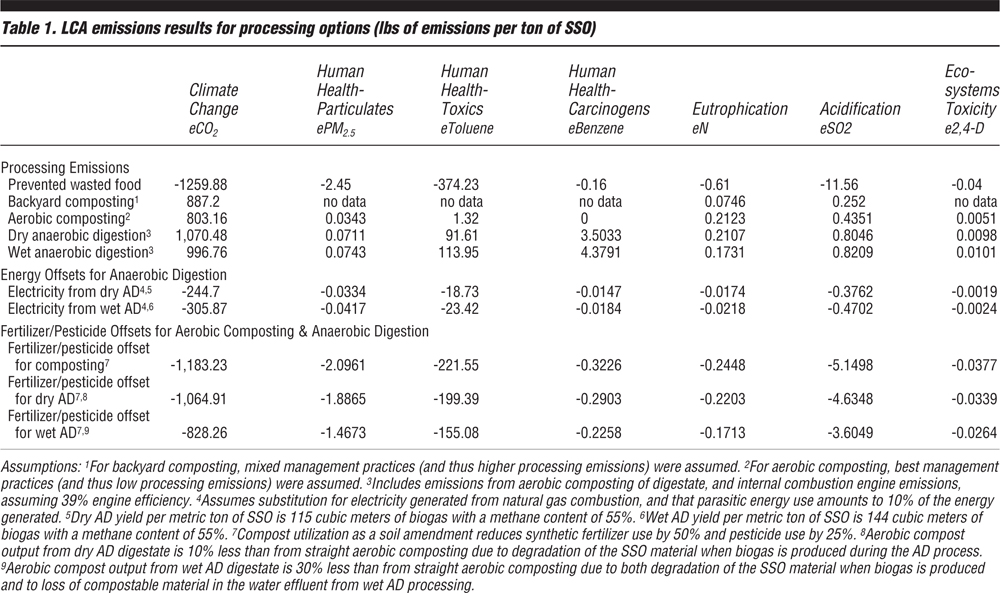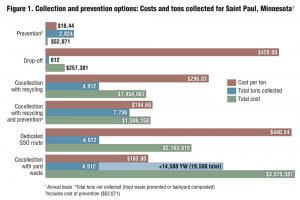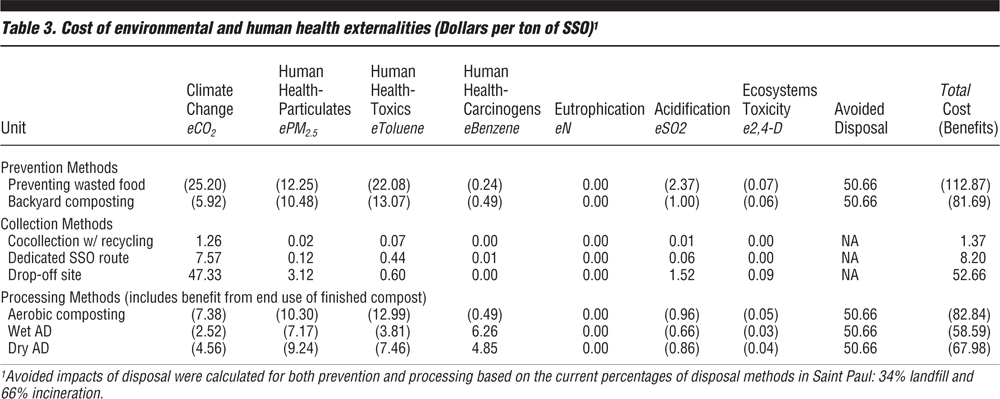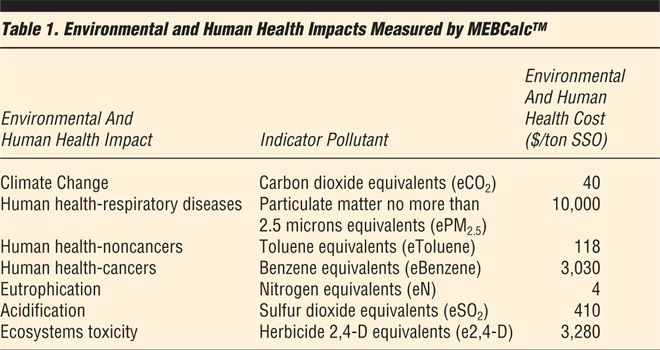An in-depth economic, social and environmental impact analysis factored in source reduction and home composting, as well as organics collection, composting and anaerobic digestion.
Joanna Stone, Kate Davenport and Bryan Ukena
BioCycle June 2014
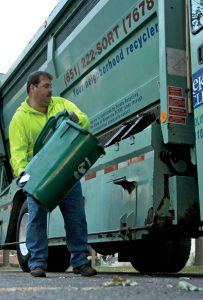
After establishing a robust prevention program, collection of the remaining SSO should be designed to leverage a community’s existing infrastructure, e.g., cocollection of SSO and recyclables. Photo by Wade Stebbings
Eureka Recycling’s report, Zero-Waste Composting: How Food Waste Can Help Conquer Climate Change and Prevent Disease, released May 2013, is the culmination of three years of work, including a study that compared cocollection of source separated organics and recyclables using a truck, bike collection, and collection at a drop-off site. It also includes an in-depth analysis of the economic, environmental, and social impacts of options for prevention, collection, and processing source separated organics (SSO). While the analysis was done looking at variables in Saint Paul, Minnesota, with the final report designed to make recommendations to that city on the best way to add compostables collection to the current recycling program, it offers a framework for other communities to evaluate their best options.
Eureka Recycling, the largest nonprofit recycler in the country, has been composting since its beginnings in 2001. It has always taught community workshops on composting at home — both in backyard bins and with worms. It also has been working to establish a citywide curbside composting program since its 2002 collection pilot revealed that cocollection of recyclables with SSO could double the amount of material being diverted from Saint Paul’s waste stream. That increased diversion potential hasn’t diminished. According to the Minnesota Pollution Control Agency’s 2013 Statewide Waste Characterization, over 31 percent of the solid waste in Minnesota is food waste and nonrecyclable paper that ends up in landfills and incinerators, where it generates emissions that are toxic and contribute significantly to climate change.
What Is Zero-Waste Composting?
Eureka Recycling’s report shows that all composting methods create significant environmental and human health benefits when compared with disposing of materials in a landfill or incinerator, and that the extent of these benefits increases greatly based on whether or not we prevent wasted food and how we choose to compost our food waste. The results indicate that zero-waste composting isn’t just about collection (although which collection method is used does matter) as much as it is about prevention — both preventing food from being wasted in kitchens and preventing collection through on-site backyard composting.
In Zero-Waste Composting, each prevention, collection, processing and end use option was measured in terms of cost per ton, jobs created, and environmental and human health impact based on a life cycle analysis completed for this project using the MEBCalcTM model developed by team member Jeffrey Morris of Sound Resource Management Group, Inc. in Olympia, Washington. The accompanying sidebar explains the MEBCalcE methodology, and dollar values assigned to environmental and human health externalities. Using this data, a framework was created for comparative analysis of the economic savings and costs and the environmental and social benefits of each of the choices made in designing programs to prevent and compost food waste. By using the Zero-Waste Composting framework, a community, business or advocacy group can determine the combination of cost and social and environmental benefits that best meet their community’s needs.
Prevention
Prevention is first in zero-waste composting. It is not an afterthought or an add-on. Food itself is a valuable resource grown in precious topsoil and purchased to nourish people and their families, never with the intention of throwing it away uneaten. But wasted food is a serious issue. The total value of avoidable food waste in the United States is as high as $198 billion/year, with over 60 percent occurring at the consumer level. This equates to a family of four wasting approximately $1,600 of food every year (Venkant, 2012). By providing engaging education and practical tools that help community members shop smarter and store food better, more of the food in their kitchens can nourish people as they intended. Similarly, by teaching interested residents to compost in their backyard or with an indoor worm bin, they can be empowered to produce their own fertilizer in their own homes and yards while reducing the amount of material that needs to be collected.

Providing engaging education and practical tools such as meal planners can help community members shop smarter and store food better, leading to less wasted food. Photo courtesy of Eureka Recycling
The key finding of this report is that prevention programs — including preventing wasted food and backyard composting — create greater environmental and social benefits and are more cost-effective than any composting method. Prevention programs have absolutely no transportation emissions since the material is reduced or handled on site, which saves between $1.37 and $52.65/ton in environmental and human health costs (depending on how the SSO would have been collected). In addition, preventing wasted food reduces upstream production and transportation emissions. As an alternative to disposal, preventing food waste results in almost 40 percent more environmental benefits than collecting and composting it.
Prevention programs are often overlooked because not all organic waste is preventable (like banana peels) or possible to compost in a backyard (like meat and dairy products), and it appears simpler and cheaper to just ask residents to set all of their SSO out for collection. Eureka Recycling’s study found that residents are interested in and willing to participate in prevention programs, and that including prevention with an organics collection method can reduce the overall costs of the composting program by more than $100/ton.
Cocollection
After establishing a robust prevention program, collection of the remaining SSO should be designed to leverage a community’s existing infra-
structure to most efficiently collect material with the lowest costs and least transportation emissions. Cocollection of SSO with another material in the same truck (in separate compartments when needed) reduces the number of trucks needed for collection. A dedicated route for SSO costs over twice as much as cocollection, and the emissions from a dedicated route have an environmental cost that is almost six times more harmful than cocollection.
The tonnage estimates and cost analysis presented in Figure 1 are specific to Saint Paul. They were calculated based on the city’s size (geographic size and population), current costs of hauling and disposal in Saint Paul, and seasonality of yard trimmings collection in Minnesota, and based on use of the City’s current recycling infrastructure. The Cocollection with Recycling scenarios assume that the current recycling fleet is modified to allow for the collection of organics in a separate compartment on the existing trucks. The cocollection with yard trimmings scenario assumes the addition of a second fleet of trucks, because Saint Paul does not currently have organized collection of yard trimmings. This type of economic analysis could be adapted to other cities based on that city’s size, hauling costs and existing infrastructure.
Collection Via Drop-Off
Drop-off sites should not be considered as a main strategy for collecting SSO from a large urban community like Saint Paul because of their comparatively high cost, large impact from emissions, and low participation rate. However, drop-offs can play an important role in providing immediate access to composting for all residents during a new program rollout, including those living in apartment buildings.
The cost to run a drop-off is more than twice the cost per ton of a curbside program that uses cocollection, and drop-offs have very low participation rates because fewer residents are willing to transport their SSO to the drop-off than are willing to bring it to their curb. Study results show that more than eight times as much material is recovered from a curbside collection program versus a drop-off site program.
In addition to these challenges, emissions from drop-offs are 38 times more environmentally harmful per ton compared to cocollection. This is due to the cumulative emissions from residents’ vehicles driving to the drop-off site every week. These emissions estimates are even higher than for other types of drop-offs (like recycling) because more residents tend to make dedicated trips to a SSO drop-off site to reduce the amount of time that their bin filled with food scraps is in their car. Adding SSO collection to an existing recycling drop-off site can mitigate some of the cost impact, however the nature of hauling food waste in a car will still result in emissions from the dedicated trips.
SSO Processing
After as much prevention as possible, the remaining residential SSO should be brought to a facility that will compost the material aerobically, since aerobic composting of SSO collected from a residential program provides the most favorable economic, social and environmental benefits. Aerobic composting methods — including windrows, aerated static piles, and in-vessel composting — provide a savings of $83/ton in environmental and human health costs when compared with disposing of materials in a landfill or incinerator. This analysis accounts for any benefit from landfill methane capture and energy generation from waste to energy facilities.
Eureka Recycling’s report also analyzed anaerobic digestion (AD) as a processing option (both wet and dry), and found that the type and volume of material produced in a residential program is not well-suited to AD because its composition is highly variable and it has a relatively low Btu value per ton due to its high paper content. While anaerobic digestion of residential SSO still generates a net environmental benefit, aerobic composting (which has a significantly lower cost than AD) results in 22 percent greater environmental benefit than dry anaerobic digestion and 44 percent more than wet anaerobic digestion — even after factoring in the benefit of energy production. The assumptions and calculations that went into this analysis are included in Table 1, and the net life cycle analysis (LCA) emissions for each processing method are listed in Table 2.
Any processing facility should be appropriately sized. With zero-waste composting, it is important to consider that the amount and type of material to be processed will change because of future food waste reduction, packaging legislation and backyard composting. Overbuilding capacity for recycling or composting, as we have seen done with waste disposal, inhibits prevention because the facility is financially built to work at a larger size, thereby creating economic and political pressure to deliver more tons to the facility, not to reduce how much goes there.
Use Of Compost
A mechanism to use finished compost locally — and funding for that mechanism — should be built into a composting program to maximize its benefit to the community. There is a critical need for healthy soil everywhere, especially in urban communities, where soil may be deficient in organic matter and/or can be contaminated with heavy metals and other pollutants. According to Eureka Recycling’s report, every ton of compost used in place of petrochemical fertilizers saves $48.82 in environmental and human health costs.
Bringing finished compost back to a community can also be a powerful tool for community building — especially when used to remediate soil or a resource to support existing local food and community gardening movements. As demand for finished compost increases, it will be important for communities to prioritize and establish mechanisms that ensure the community benefits from the compost created by their program. Although returning finished compost to urban communities adds to the cost of the program, soil is frequently being shipped into these communities at a much greater cost from other parts of the state, and sometimes even from out of state.
Dollar Value Of Composting Benefits
To calculate and summarize the environmental and human health benefits of methods to prevent, collect and process SSO, Eureka Recycling’s report relies on MEBCalcTM to translate each emissions category into a dollar value that represents the societal, environmental and human health costs per ton of pollutants (see sidebar on methodology for more details). By translating pollutants into dollars, the report can more easily compare composting methods and express their impact on humans and the environment in a way that can be more universally understood.
For example, Table 3 shows that one ton of SSO that is prevented saves society $112.87 by avoiding the environmental and human health impacts that would have occurred if that material had been wasted. One ton of SSO that is cocollected with recyclables and then sent to an aerobic composting facility saves society $81.47 in environmental and human health costs ($82.84 less the $1.37 cost of cocollection).
Leveraging Existing Infrastructure
Based on the findings of Zero-Waste Composting, a community’s composting program should be designed to utilize and expand on existing infrastructure. This approach improves cost-effectiveness by minimizing capital expenses and allowing for efficiencies of scale. It improves environmental impact by reducing the number of trucks and amount of processing equipment required. It also improves the social benefits of the program by increasing access to residents and providing comprehensive education that ties together related issues.
Overall suggestions in terms of leveraging include:
• For prevention, an education campaign can be combined with other environmental issues that are important in the community (such as energy conservation).
• As discussed, using the existing recyclables collection infrastructure for SSO provides significant environmental and economic benefits. The same would be true with expanding an existing recycling drop-off site to include SSO drop-off.
• Utilizing existing processing capacity is vital to the cost-effectiveness of a program. As discussed in detail in the full report, larger scale facilities have significantly lower processing costs. When possible, utilizing an existing facility in a community can allow a smaller program to benefit from lower processing costs and avoid the capital costs of building its own facility.
As part of this study, alternative systems such as bike collection and composting at community gardens were studied. There were numerous benefits to these methods, however, in the context of a citywide program, they were not included in this evaluation due to limited scalability or logistical constraints. More information is available at www.MakeDirtNotWaste.org.
Joanna Stone, Program Development Manager, Kate Davenport, Director of Business Development, and Bryan Ukena, Co-President, all work at Eureka Recycling, a zero waste organization based in the Twin Cities of Saint Paul and Minneapolis, Minnesota. Other contributing authors include Susan Hubbard, principal at Nothing Left to Waste in Saint Paul, Minnesota, and former CEO of Eureka Recycling, and Jeffrey Morris, principal at Sound Resource Management Group in Olympia, Washington.
